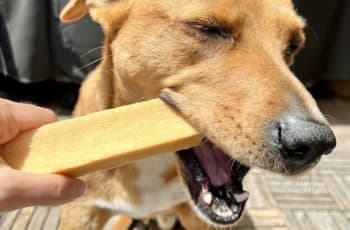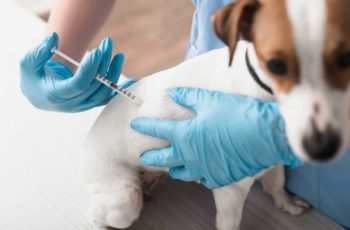This post may contain affiliate links. We may earn money or products from the companies mentioned in this post.
As dogs age, some of their behaviors and appearances change. You may wonder why your dog is getting warts as it gets older.
There are actually two main reasons why older dogs get warts: the first cause is canine papilloma virus, and the second is squamous cell carcinoma.
Of the two conditions, one is benign, while the other can be very serious.
Warts caused by canine papilloma virus are benign warts, meaning they are not harmful to your dog’s health and they do not always need to be removed.
Meanwhile, warts caused by squamous cell carcinoma can be very serious and need medical treatment in order for them to not affect your old dog’s health in the long run.
Unfortunately, you won’t know the difference between the not-so-serious warts and the serious warts just by looking at them and will need a vet visit to determine their nature and severity.
Keep reading if you are worried about or just interested in your old dog’s warts.
DISCLAIMER: We are not veterinarians. This blog post is for entertainment purposes only. If your dog has any health issues please consult your veterinarian.

Contents & Quick Navigation
Why Do Older Dogs Get Warts?
Whether the warts are due to the canine papilloma virus or are caused by squamous cell carcinoma, they tend to develop in dogs with a suppressed immune system.
Dogs who are sick, have chronic allergies, are on medications for chronic illnesses, or are older all have suppressed immune systems.
If the immune system is suppressed or not as strong as it should be, like in the case of older dogs, then it cannot deal with viruses the same way a younger, healthier dog’s immune system would.
Ideally, a healthier dog’s immune system would fight the virus and prevent it from developing the warts on your dog’s skin.
In this case, you may not even know your dog was sick if they had the canine papilloma virus.
However, if the immune system is suppressed or inactive, the virus is allowed to spread, and you will notice the development of warts.
The development of these warts, where they are on the body, and their accompanying symptoms are different depending on whether they are caused by canine papilloma virus or squamous cell carcinoma.
Read on to get a more detailed breakdown of the two conditions and how they may affect your dog.
Canine Papilloma Virus Warts
Let’s take a closer look at all things canine papilloma virus.
1. What Do They Look Like?
Canine papilloma virus warts can take on a few different appearances:
- The wart can be a small bulb attached to a stalk that comes out of the skin; it looks a little like a head of broccoli or cauliflower
- The bulb is usually rough to the touch
- There can be a single wart or cluster of them which appear like a plaque
- They can also be inward-growing, meaning they are beneath the skin and will feel like a small lump
- In extreme cases, the warts may take over a large area of the body and look like a solid mass
Regardless of what the wart looks like, it will feel firm. If the wart feels soft, squishy, or it feels like it is filled with fluid, then it is more likely to be a cyst that needs to be drained by a vet and should not be squeezed or popped at home.
2. Where Will I Find Them?
Canine papilloma virus warts are commonly found on or near mucus membranes:
- Near the eyes
- On the eye and the lid
- Around or in the mouth
- Around the genital and anal area
Sometimes, canine papilloma virus warts also grow in clusters or plaques between the toes.
3. Are They Dangerous?
Canine papilloma virus warts are not inherently dangerous, and they will typically regress within a few months. However, their position and the extent of the warts may cause your old dog to have other issues.
If your dog has warts on their lips or in their mouth, then they may not want to eat or drink and can become malnourished or dehydrated.
If they have warts on their feet, then they can have issues walking. Alternatively, if they have warts on their anal area, then pooping can become a problem, and a secondary infection may set in.
If the warts are scraped or become an open wound, then there is also the risk of secondary infection. If your dog has canine papilloma virus warts, they need to be dealt with carefully during grooming.
4. Are They Painful?
If the warts are small, individual, and not in a sensitive place, then they should not cause your dog any pain.
However, if the warts are very large, inside the mouth, around the eyes, near the anus, or covering a large portion of their body, your dog could be in considerable pain.
5. How Do They Spread?
Canine papilloma virus warts are spread by touching a surface contaminated by the virus such as dirty blankets, toys, or food and water bowls.
The virus can live for a long time outside of the body; therefore, it is very important to keep these items clean.
Canine papilloma virus warts can also be transferred from dog to dog. This commonly happens when dogs frequent parks or day cares where they are exposed to other dogs who are infected.
If you know your dog currently has canine papilloma virus, the responsible thing to do is to keep them at home until the virus is gone.
Old dogs are more susceptible because their immune systems are not strong enough to fight the virus off.
6. How Are They Treated?
Your dog’s vet will diagnose the warts through a physical exam and possibly a biopsy. In most cases, the warts resolve themselves within three months.
Your vet will keep an eye on them with check-ups to make sure the warts are regressing and not spreading further.
If the warts are not regressing, your vet may prescribe antivirals and immune boosters to help your dog’s body fight off the virus.
7. Can I Prevent My Dog From Getting Them?
It would be very difficult to prevent your dog from getting canine papilloma virus warts if they come into contact with other dogs or spaces and things where other dogs have been.
Ensuring a healthy immune system is the only way to help them fight off the virus quickly.
Squamous Cell Carcinoma Warts
Next, let’s take a closer look at squamous cell carcinoma warts.
1. What Do They Look Like?
Squamous cell carcinoma warts look very similar to canine papilloma virus warts. However, they will often also appear red and irritated.
2. Where Will I Find Them?
Squamous cell carcinoma warts are most commonly found on the head, the abdomen (don’t mistake them for extra nipples), the lower legs, in the nail bed, and the haunches.
Many experts believe the squamous cell carcinoma warts show up where there is more skin exposed to the sun; however, this is not always the case.
3. Are They Dangerous?
All cancers are dangerous, and squamous cell carcinoma often does not respond well to treatment.
Once the squamous cell carcinoma has appeared, there is a one-to-three-year life expectancy if the cancerous cells cannot be fully removed.
In addition to the cancer being dangerous, secondary infection needs to be considered, too.
4. Are They Painful?
Unlike canine papillomavirus warts, squamous cell carcinoma warts are almost always painful to the touch.
5. How Do They Spread?
If your dog has developed squamous cell carcinoma warts, then they can spread within the body through the lymphatic system.
6. How Are They Treated?
Squamous cell carcinoma does not respond well to chemotherapy, which means surgical intervention is required. The individual warts are excised by a vet.
7. Can I Prevent My Dog From Getting Them?
There is no foolproof way to prevent your dog from getting squamous cell carcinoma.
However, you can lower their chances of developing it by limiting their exposure to the sun or using a sunscreen when they are outside and restricting their access to dogs or areas contaminated with canine papilloma virus.
FAQs About Warts On Old Dogs
Can I catch warts from touching the warts on my dog?
Canine papilloma virus and squamous cell carcinoma warts cannot be transmitted between dogs and humans.
Which dog breeds are more prone to getting canine papilloma virus warts?
Pugs, Shar-Peis, Schnauzers, and Kerry blue terriers are all known to be more susceptible to canine papilloma virus warts.
Which dog breeds are more prone to getting squamous carcinoma warts?
Standard poodles, basset hounds, and bloodhounds are most susceptible to squamous cell carcinoma.
Old dogs often have small skin growths that are smooth to the touch and can appear anywhere on their body.
This is because cell replication goes a bit wonky as dogs age, and the result is often a small, benign skin growth.
| Wart | Skin growth |
| Rough texture | Smooth texture |
| Caused by canine papilloma virus or squamous cell carcinoma | Caused by age |
| May be benign or cancerous | Benign |
| Must be treated by a vet | Does not need to be treated |
Is there a link between canine papilloma virus and squamous cell carcinoma?
There is some research which states older dogs who have had canine papilloma virus in the past have a higher chance of developing squamous cell carcinoma in the future than dogs who have never contracted the virus.
Final Thoughts
There are many potential health issues to worry about when thinking about your fur babies. Many people wonder why dogs get warts when they get older.
As dogs age, they can develop skin tags or small growths, which are benign and just a sign of age.
However, dogs can contract canine papilloma virus and develop warts as a symptom. Fortunately, canine papilloma virus is rarely harmful if it is treated promptly.
Canine papilloma virus is more common in dogs with a lowered immune system like older dogs.
Dogs can also develop wart-like tumors if they have squamous cell carcinoma. Squamous cell carcinoma is very serious and can be fatal if not caught early enough to successfully remove the tumors.
To recap, canine papilloma virus warts are commonly found:
- Near the eyes
- On the eyes and lids
- Around the mouth
- Around the anal/genital area
Meanwhile, squamous cell carcinoma warts are typically located:
- On the head
- On the abdomen
- Along the lower legs
- In the nail beds
- On the haunches
Keep an eye out for any lumps and bumps on your dog’s body, and get them seen by a vet at least once a year for a check-up.
Save To Pinterest

Top Picks For Our Dogs
- BEST PUPPY TOY
We Like: Calmeroos Puppy Toy w/ Heartbeat and Heat Packs – Perfect for new puppies. Helps ease anxiety in their new home. - BEST DOG CHEW
We Like: Bones & Chews Bully Sticks – All of our puppies love to bite, nip, and chew. We love using Bully Sticks to help divert these unwanted behaviors. - BEST DOG TREATS
We Like: Crazy Dog Train Me Treats – One of our favorite treats for training our service dog puppies. - BEST FRESH DOG FOOD
We Like: The Farmer’s Dog – A couple months ago we started feeding Raven fresh dog food and she loves it! Get 50% off your first order of The Farmer’s Dog.
For a list of all the supplies we get for our new service dog puppies check out our New Puppy Checklist on the PuppyInTraining.com blog.
Two Main Causes Of Warts In Older Dogs (Finding The Facts) was last modified: March 8th, 2023 by


